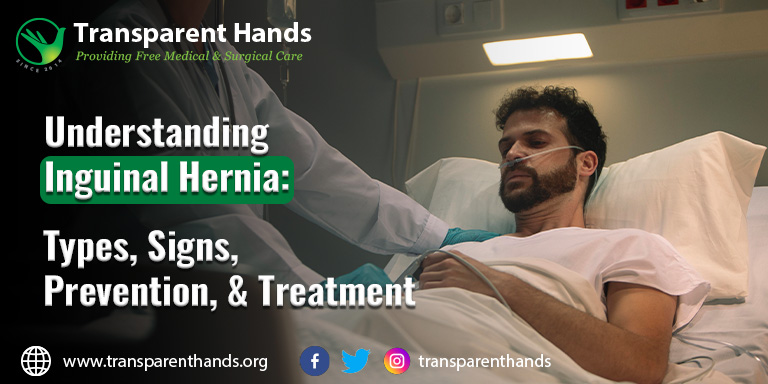Understanding Inguinal Hernia: Types, Signs, Prevention, and Treatment

An inguinal hernia is a common medical condition characterized by the protrusion of abdominal contents through the inguinal canal in the groin area. It occurs when a weakened spot in the abdominal wall allows organs or tissues to push through. Inguinal hernias can cause discomfort and pain, and if left untreated, they may lead to serious complications. In this article, we will delve into the details of this medical condition, including its types, signs, prevention strategies, and available treatment options.
What is Inguinal Hernia?
An inguinal hernia occurs when a portion of the intestines or fatty tissue protrudes through a weak spot in the abdominal muscles. The inguinal canal, located in the groin, is a passageway that houses the spermatic cord in men and the round ligament of the uterus in women. This condition is more prevalent in men than women, and it can occur on one or both sides of the groin.
Types of Inguinal Hernia
1.Indirect Inguinal Hernia
This type is the most common and typically occurs due to a congenital weakness in the inguinal canal. During fetal development, the inguinal canal fails to close completely, leaving a potential opening for herniation later in life. Indirect inguinal hernias may manifest at any age, from infancy to adulthood. They have a higher incidence in males and can sometimes extend into the scrotum. This type of hernia often occurs due to straining or increased pressure on the abdomen.
2.Direct Inguinal Hernia:
Direct inguinal hernias are more common in older individuals and are caused by the weakening of the abdominal wall muscles. Unlike indirect hernias, direct hernias do not extend into the scrotum and are usually confined to the groin area. This type of hernia occurs due to the gradual weakening of the muscles and connective tissues in the abdominal wall over time. Factors such as aging, heavy lifting, chronic coughing, and obesity can contribute to the development of this type of hernia.
Signs of Inguinal Hernia
Recognizing the signs and symptoms of an inguinal hernia is crucial for early detection and prompt medical intervention. Common indicators include:
- Bulge or Lump: The most apparent sign of an inguinal hernia is a bulge or lump in the groin area. The bulge may be more noticeable when coughing, sneezing, or straining. In men, the bulge may extend into the scrotum.
- Pain or Discomfort: Hernias can cause varying degrees of pain or discomfort in the groin region. The pain may worsen with physical activity or lifting heavy objects. Some individuals may experience aching or burning sensations in the affected area.
- Weakness or Pressure: Some people with this condition may feel a sense of weakness or pressure in the groin, especially when standing or bending over.
- Swelling or Enlargement: The affected area may become swollen or enlarged due to the protrusion of abdominal contents.
Prevention of Inguinal Hernia
While some factors leading to inguinal hernias are beyond our control, adopting certain lifestyle habits may help reduce the risk of developing this condition. Consider the following preventive measures:
1. Maintain a Healthy Weight:
Obesity and excessive weight can put strain on the abdominal muscles, increasing the likelihood of a hernia. Focus on maintaining a healthy weight through a balanced diet and regular exercise. Include fiber-rich foods, fruits, vegetables, and lean proteins in your diet while limiting processed and high-fat foods.
2. Practice Proper Lifting Techniques:
When lifting heavy objects, use your legs rather than your back. Bend your knees and keep your back straight to minimize strain on the abdominal muscles. Avoid lifting objects that are too heavy for you. If necessary, ask for assistance.
3. Avoid Straining during Bowel Movements:
Straining during bowel movements can increase pressure on the abdominal muscles. Ensure you have a high-fiber diet and stay hydrated to maintain regular bowel movements. Include foods such as whole grains, fruits, vegetables, and legumes in your diet to promote bowel regularity.
4. Strengthen Your Core Muscles:
Engaging in exercises that target the abdominal muscles can help strengthen the muscles and reduce the risk of hernias. Incorporate exercises like planks, sit-ups, pelvic tilts, and yoga into your fitness routine. Consult a healthcare professional or a certified trainer to learn proper techniques and exercises suitable for your fitness level.
5. Quit Smoking:
Smoking weakens the connective tissues in the body, making them more susceptible to hernias. Quitting smoking can improve your overall health and reduce the risk of hernias.
Treatment of Inguinal Hernia
The treatment of an inguinal hernia typically involves surgery, as hernias do not resolve on their own. There are two primary surgical approaches:
1. Open Hernia Repair:
This traditional approach involves making an incision near the hernia site to access and repair the weakened abdominal wall. The surgeon may reinforce the area with stitches or a synthetic mesh to prevent future hernias. Open hernia repair is generally performed under local or general anesthesia.
2. Laparoscopic Hernia Repair:
In this minimally invasive procedure, the surgeon makes a few small incisions and inserts a laparoscope and surgical tools to repair the hernia. The laparoscope provides a visual guide for the surgeon to repair the hernia using sutures or a mesh. Laparoscopic hernia repair generally results in less postoperative pain, smaller scars, and a quicker recovery time compared to open hernia repair.
Conclusion
Inguinal hernias are a common medical condition that can cause discomfort and pain if left untreated. Recognizing the signs and symptoms and adopting preventive measures can help reduce the risk of developing this condition. However, if a hernia does occur, surgical intervention is typically required to repair the weakened abdominal wall. Consult a healthcare professional for an accurate diagnosis, personalized advice, and appropriate treatment options to ensure a prompt and effective resolution of concerns related to the types of this hernia. Remember, early detection and treatment are essential for a successful recovery.










Leave Your Comments